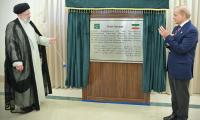Islamabad
The six-day training programme in Chunri (tie and dye) and ‘Kite Making: Engagement with Artisans’, organised by the National Institute of Folk and Traditional Heritage (Lok Virsa) to mark Basant celebrations successfully concluded on Sunday.
On this occasion, the venue of Heritage Museum was decorated with beautiful Chunri and kite items and related accessories. The concluding day also featured a one-day Basant Festival. A large number of people especially youth and families from the twin cities of Islamabad-Rawalpindi attended the festival and enjoyed the music and kite flying.
The training programme was part of the series of programmes that Lok Virsa is currently holding under the title ‘Craft of the Month’ with an objective to promote traditional skills, giving knowledge to younger generation about the importance and utility of different crafts and provide opportunity to youth to learn about Pakistan’s rich, diverse and pluralistic cultural tapestry. The initiative also encourages youth to value dignity of labour, foster ownership for their culture, create respect for different professions and character building. It helped understand the contribution of artisans in the sustainable development of their community and country at large.
Children studying in various schools and colleges working under the administrative control of Federal Directorate of Education (FDE), Directorate of Special Education, Iqra University and other institutions participated in the programme apart from children of the visitors to Lok Virsa museums. They learnt craft making techniques from master trainers and artisans from March 1 to 6, 2016.
Master artisans, who imparted training to youth in Chunri (Tie and Dye) were Ameer Mai, Shamim Mai, Razia Bibi and Muhammad Farhan, whereas the kite makers included Muhammad Qaiser, Muhammad Nasir and Abdul Basit. All these artisans hailing from Southern Punjab possessing a vast knowledge and experience of association with the profession, were nominated by Cholistan Development Foundation, Bahawalpur for this particular training programme.
Sharing her experiences, 60-year old Chunri artisan from Cholistan Ameer Mai said that she learnt this art from her mother at the age of five. “She was also an excellent Chunri maker. In our community, ladies do this work with utmost dedication. I have trained around 25 girls, who have now enough knowledge to transfer this art to others. For me, it was a unique experience to teach Chunri making techniques to children under the guidance of Lok Virsa. Some children were very intelligent and they got a lot in a little time".
Another artisan Shamim Mai told that the idea of providing training classes to children is excellent. She said though she had trained young girls in her native town in Bahawalpur but these training classes with children of a developed urban area like Islamabad were a memorable experience for her.
“They have even given me ideas and suggestions on how can I make new innovations in my craft. Here I would like to make special mention of the students of Iqra University who showed a tremendous interest in the Chunri training process," she said.
Kite maker Muhammad Nasir told that due to ban on kite flying, kite makers have suffered a lot. “Lok Virsa deserves appreciation for reviving the centuries old tradition of kite making and providing incentives to practitioners associated with it. I am providing training to a group of 15 school students. Their enthusiasm is worth mentioning", he maintained.
Lok Virsa Executive Director Dr Fouzia Saeed said that Pakistani children have a great potential to learn about country’s rich craft heritage.
Chunri (tie and dye) is one of the traditional dying crafts of Pakistan. It began about 5,000 years ago and called as bandhani or Chunri. This technique involves tying small dots with thread all over the fabric to create designs and motifs. After tying, the fabric is dyed then the ties are removed and a beautiful pattern forms on the fabric. Most popular material to use is cotton as it is soft and easy to handle. Regarding kite making, it is believed that the art originated from China and then it found its roots in the entire South Asia including Pakistan.
Punjab University building in Lahore. — Facebook/Punjab University/File LAHORE:Punjab University’s 133rd...
Officials of Tevta and Pakistan Solar Association sign a MOU during A signing ceremony on April 22, 2024. —...
A female voter casting her vote in a polling station during the by-election 2024 at Garhi Shahu School on April 21,...
Punjab Provincial Health Minister Khawaja Salman Rafique chairs a meeting in this still released April 1, 2024. —...
Election officials count ballot papers after polls close at a polling station. — AFP/FileLAHORE:Punjab Local...
Punjab police personnel stand guard in the city on October 3, 2023. — Facebook/DIG Ops Lahore...







